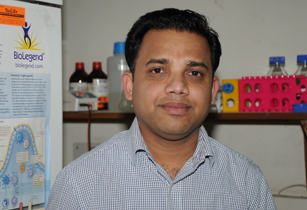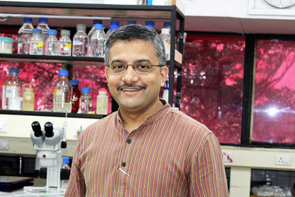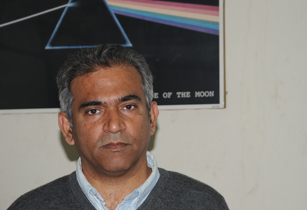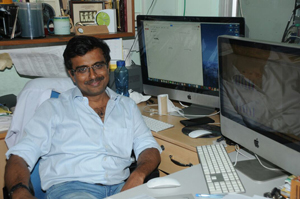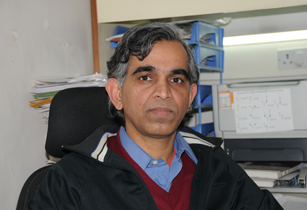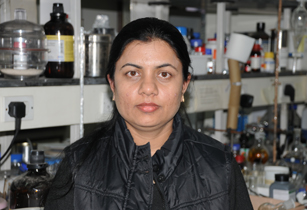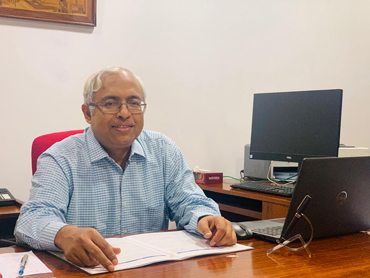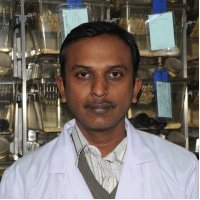Dr. Apurba Kumar Sau
Molecular mechanism of regulatory processes, Structural Biochemistry, Antibacterial and antimicrobial target enzymes and their functions, Drug-design, Protein biochemistry
The primary focus of our research is to understand how enzymes/receptors work at the molecular level and this helps in-depth mechanistic understanding and thereby provides a more effective way of modulating their functions. We are mainly interested in those enzymes/receptors that are important targets for the design of antibiotics and antimicrobial agents etc. The functional studies along with the structural data may provide to design inhibitors/drug candidates for therapeutic purposes. We are using a combination of molecular biology, biochemical, kinetic, thermodynamic and structural approaches such as rapid transient kinetics, mass spectrometry, circular dichroism, fluorescence, isothermal calorimeter and x-ray crystallography to address these problems.
Interferons induced GTPases
Interferons (IFN) are immunomodulatory cytokines that mediate anti-pathogenic and anti-proliferative effects in cells. The guanylate-binding proteins, known as GTPases are among the most abundant proteins induced by IFN-gamma. They constitute two families of GTP binding proteins with molecular masses 47 and 65-67 kDa, respectively. The p47 GTP binding proteins have been indentified in mammals but the p67 GBPs (hGBP1, hGBP2 etc) have been found in all vertebrates including human, mouse etc. In contrast to all other GTPases, which hydrolyze GTP to GDP, hGBP1 catalyzes the hydrolysis of GTP to a mixture of GMP and GDP, with GMP being the major product. It has been found that this protein blocks the replication of vesicular stomatitis, encephalomyocarditis viruses in HeLa cells and more recently influenza, whereas the mechanism leading to this effect is unknown and it also antagonizes the proliferation and angiogenic activity of endothelial cells on inflammation. However, the antiviral activity is much weaker than human MxA, another group of proteins within the super family of dynamin related large GTPase, which are induced by interferon-alpha. The p47 GTPases act as antimicrobials in cells; they appear to suppress Toxoplasma gondii, Listeria monocytogenes, Mycobacterium spp. The structure-functional relationship is important in view of understanding how these proteins work at the molecular level. We recently identified an alpha helix of the intermediate domain which acts as an internal GAP (GTPase activating protein) in hGBP1 (J. Mol. Biol (2009), 386, 690-703).
Biosynthetic pathways in Helicobacter pylori
Helicobacter pylori, a human pathogen infects the stomach of half of the population worldwide and causes chronic active gastritis, which can lead to peptic ulcer disease, gastric adenocarcinoma, and mucosa-associated lymphoid tissue (MALT) lymphoma. Current antibiotic therapy requires a combination of drugs with long term treatment. Moreover, the emergence of drug-resistant strains in human pathogens has gained further attention towards the development of new drugs. We are therefore interested in the biosynthetic pathways of the microorganism that are not present in mammals and hence may be an attractive target for the design of new antibiotics.
Our lab would be primarily interested in the following topics:
- To understand the mechanism of these enzymes using various approaches
- To investigate the mechanism by which hGBP-1 blocks the replication of VSV and EMCV
- To understand how p47 GTP-binding proteins act as antimicrobial in cells
Divya Rashmi, Anjali Kalia, Anirban Molla, Pratiti Bakshi, Dorle Archana Mukund, Samriddhi Dubey, Sangita Dey and Ashma Khan
Past Members- Dr. Nazish Abdullah, Dr. Abhishek Srivastava, Dr. Esha Pandita, Dr. Sudeepa Rajan, Dr. Nikunj H Raninga, Dr. Vineet Sadarangani, Dr. Ankita Dutta, Dr. Ditsa Sarkar, Dr. Sowmiya Gupta, Dr. Monika Mittal, Shiv Kumar Meena, Meena Balakumari, Bharani Srinivasan, Anjana Rani, Nidhi Dwivedi, Tooba Quidwai, Ginto George, Upma Dave, Pratima Verma, Dr. Sadaf Fatima, Dr. Maskoor Alam, Dr. Safikur Rahman, Dr. Saurabha Srivastava, Dr. Rachana Tomar, Dr. Shruti Mathur, Dr. Pooja Muraka, Dr. Tasneem Kausar and Dr. Ankita.
Awards:
• Fellow of National Academy of Sciences, India (2017)
• National Bioscience Award for Career Development (2013)
- Anirban Molla, Ditsa Sarkar, Ashma Khan, Vijayan Ramachandran, Tasneem Kausar, Samudrala Gourinath, and Apurba Kumar Sau* (2025) Structural and Functional Insights into the Regulation of Helicobacter pylori CPA Activity by an Evolutionarily Conserved Motif. Biochemistry, (DOI: 10.1021/acs.biochem.5c00045, Selected as a front cover of Biochemistry).
- Sowmiya Gupta, Aunji Pradhan, Divya Rashmi, Monika Mittal, Saumitra Das, and Apurba Kumar Sau* (2024) Helical domain changes between hGBP3 and hGBP3ΔC result in distinct oligomers and anti-HCV activity. Biochemistry, 63, 2892–2903 [Highlighted on the front cover of Biochemistry, volume 63, issue 21].
- Divya Rashmi, Sowmiya Gupta, Tasneem Kausar, and Apurba Kumar Sau* (2024) Helical domain of hGBP3 cannot stimulate the second phosphate cleavage of GTP. J. Biol. Chem, 300, 105696-723.
- Vineet Sadarangani, Anjali Kalia, Tasneem Kausar, Pooja Murarka and Apurba Kumar Sau* (2023) Effect Of The Macromolecular Crowding Agents On The Structure And Function Of Human Arginase-I, A Therapeutically Important Enzyme. J Phys Chem B, 127, 8749-8761.
- Monika Mittal, Tasneem Kausar, Sudeepa Rajan, Divya Rashmi and Apurba Kumar Sau* (2023) Difference in Catalytic Loop Repositioning Leads to GMP Variation between Two Human GBP Homologues. Biochemistry, 62, 1509-1526 [Highlighted on the front cover of Biochemistry, volume 62, issue 9].
- Ditsa Sarkar, Ramachandran Vijayan Samudrala Gourinath and Apurba Kumar Sau* (2022) A unique aromatic cluster near the active site of H. pylori CPA is essential for catalytic function. Biophysical Journal, 121, 248-262.
- Anikta Dutta,Ditsa Sarkar, Pooja Murarka, Tasneem Kausar, Satya Narayan, Mohit Mazumder, Sri Rama Koti Ainavarapu, Samudrala Gourinath and Apurba Kumar Sau* (2021) An evolutionary non-conserved motif in Helicobacter pylori arginase mediates positioning of the loop containing the catalytic residue for catalysis. Biochemical Journal, 478, 871-894.
- Nikunj Raninga, Shahid M Nayeem, Sowmiya Gupta, Ranajoy Mullick, Esha Pandita, Saumitra Das, Shashank Deep and Apurba Kumar Sau* (2021) Stimulation of GMP formation in hGBP1 is mediated by W79 and its effect on the antiviral activity. FEBS Journal, 288, 2970-2988.
- Ankita Dutta, Mohit Mazumder, Mashkoor Alam, Samudrala Gourinath and Apurba Kumar Sau* (2019) Metal-induced change in catalytic loop positioning in H. pylori arginase alters catalytic function. Biochemical Journal, 476, 3595-3614.
- Sudeepa Rajan, Esha Pandita, Monika Mittal and Apurba Kumar Sau* (2019) Understanding the lower GMP formation in large GTPase hGBP-2 and role of its individual domains in regulation of GTP hydrolysis. FEBS Journal, 286, 4103–4121.
- Ginto George, Mamata Kombrabail, Nikunj Raninga and Apurba Kumar Sau* (2017) Arginase of Helicobacter gastric pathogens uses a unique set of non-catalytic residues for catalysis. Biophysical Journal, 112, 1120–1134.
- Esha Pandita, Sudeepa Rajan, Safikur Rahman, Ranajoy Mullick, Saumitra Das and Apurba Kumar Sau* (2016) Tetrameric Assembly Of hGBP1 Is Crucial For Both Stimulated GMP Formation And Antiviral Activity. Biochemical Journal, 473, 1745–1757.
- Abhishek Srivastava, Shiv Kumar Meena, Mashkoor Alam, Shahid M Nayeem, Shashank Deep and Apurba Kumar Sau* (2013) Structural and Functional Insights into the Regulation of Helicobacter pylori Arginase Activity by an Evolutionary Nonconserved Motif. Biochemistry, 52, 508−519.
- Nazish Abdullah, Meena Balakumari and Apurba Kumar Sau* (2010) Dimerization And Its Role In GMP Formation By Human Guanylate Binding Proteins. Biophysical Journal, 99, 2235-2244.
- Nazish Abdullah, Bharani Srinivasan, Nir Modiano, Peter Cresswell and Apurba Kumar Sau* (2009) Role of individual domains and identification of internal GAP in human guanylate binding protein-1. J. Mol. Biol, 386, 690-703.
- Cristina Furdui, Apurba Kumar Sau, Ronald W Woodard, Timor Baasov and Karen S Anderson (2005) Effect of fluorinated phosphoenol pyruvate on the mesophillic and thermophillic E. coli 3-deoxy-D-manno-octulosonate-8-phosphate (KDO8P) synthase: A transient kinetic study. Biochemistry, 44, 7326-35.
- Apurba Kumar Sau, Zhili Li and Karen S Anderson (2004) Probing the role of metal ions in the catalysis of Helicobacter pylori 3-deoxy-D-manno-octulosonate-8-phosphate (KDO8P) synthase using transient kinetic study. J. Biol. Chem, 279, 15787-15794.
- Zhili Li, Apurba K Sau, Shida Shen, Craig Whitehouse, Timor Baasov and Karen S Anderson (2003) A snapshot of enzyme catalysis using electrospray ionization mass spectrometry. J. Am. Chem. Soc, 125, 9938-9939.
- Apurba Kumar Sau, Gena D Tribble, Ian Grainge, R F Frohlich, B R Knudsen and Makkuni Jayaram (2001) Biochemical and kinetic analysis of the RNase active sites of the integrase/tyrosine family site-specific recombinases. J. Biol. Chem, 276, 46612-23.
- Apurba Kumar Sau, Shyamalava Mazumdar, J. A. Cowan and Samaresh Mitra (2001) Steady state and time-resolved fluorescence studies on Wild type and Mutant Chromatium vinosum High Potential Iron Proteins; Holo-and Apo-Forms. Biophysical Journal. 81, 2320-30.




